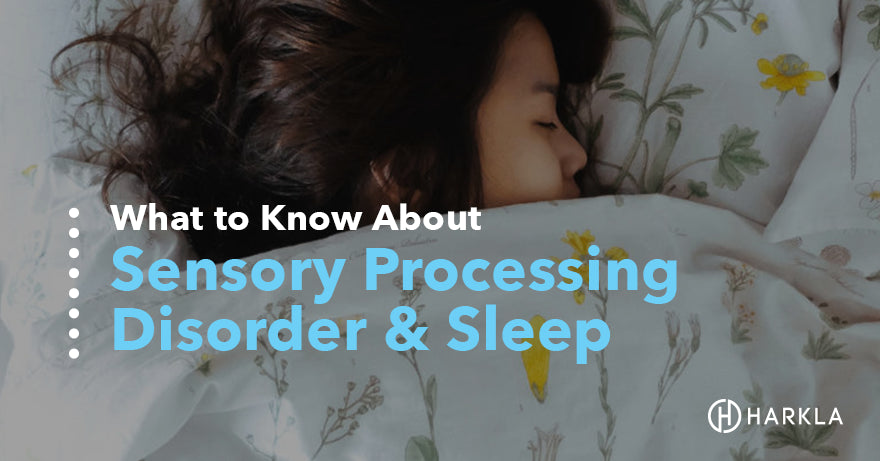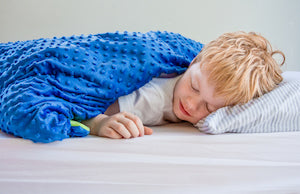Your Cart is Empty
Save up to 20% on all Harkla products & courses during Autism Acceptance Month! Click Here to See the Sale

Sleep is a critical activity that promotes self-regulation. Without a good night’s sleep, it’s likely that you’ll be irritable, inattentive, disorganized, and a bit more dysregulated the next day.
When it comes to sensory processing disorder, it can be a common occurrence for children to also have sleep issues.
Whether it’s a recurring problem or not, these symptoms of sleep deprivation can often mimic and compound the behavioral observations of children with attention deficit disorder, autism, and sensory processing disorder.
For more information on the relationship between ADHD and sleep, check out our article here.
Sensory Integration is the process your central nervous system goes through when it takes information in from your body’s 8 senses, processes that information, and then responds accordingly.
The 8 senses are:
When one’s central nervous system has difficulty processing any of this sensory information, the body’s responses are atypical and can be observed in motor, language, or behavioral skill difficulties. Occupational therapists diagnose these atypicalities as Sensory Processing Disorder or SPD.
For more information on the types of sensory processing disorder, check out our Guide to SPD here.
When a child has difficulty processing and responding appropriately to the world around him, he may experience dysregulation, or sensory overstimulation/overload. A child with SPD may have difficulty self-soothing or calming down, something that is critical to falling asleep.
Sleep is a complex process of activating and inhibiting certain parts of your brain -- it seems like a simple necessity until the process doesn’t happen as it should and you’re suffering from insomnia!
Only then do you realize the complexity of the process and all that happens while you’re trying to snooze. For the sake of oversimplifying a complex process, we’re going to focus on two main neurochemicals or hormones as they relate to sleep and sensory processing: melatonin and cortisol.
Each of our bodies has a 24-hour sleep-wake pattern called a circadian rhythm. These circadian rhythms are controlled by the hypothalamus of your brain and are essential to falling asleep and waking in a regular timeframe. The hypothalamus controls the brain’s release of melatonin, a neurochemical which helps your body become tired.
Any inconsistencies with melatonin levels can contribute to a disruption of the body’s circadian rhythm, meaning parents would have to work extra hard to make a non-drowsy child ready for bed! This is often the case when a child presents with dysregulation associated with sensory processing disorder - instead of having low levels of melatonin during the day and high levels at night (to trigger drowsiness), the opposite can happen and cause a disruption in the sleep cycle.
Another neurochemical that plays a role in sleep cycles is cortisol. Cortisol is the major stress hormone that is produced when children are anxious, stressed, overstimulated, and/or in sensory overload. Typically, cortisol levels should be higher in the morning (to wake up the body and brain) but gradually decrease over the course of the day, until eventually being at a low point when it is time to sleep. Again, the opposite can happen if the child is in a constant dysregulated state due to sensory processing issues.
Essentially, sleep is a neurochemical process that acts to restore our bodies and brains for a new day of learning and functioning. When the neurochemicals are not interacting appropriately to regulate your sleep-wake cycle or sleep patterns (REM, non-REM), sleep issues exist and daily functioning is impacted.
We know that children with sensory processing disorder experience high levels of cortisol and low levels of melatonin, the opposite of what is typical (and recommended) to support sleep cycles.
Research indicates that behavioral and physiological measures are able to predict good sleepers versus poor sleepers with 85.7% accuracy, suggesting that atypical sensory behaviors are important to consider in relation to sleep deficits in children.
In fact, much of the focus of sensory integration therapy is to elicit the production of neurochemicals to counterbalance one another to support regulation and arousal, including the process of sleep.
If your child is having difficulty sleeping due to a sensory processing disorder, consult his occupational therapist for a sensory diet that is specifically designed to support his bedtime routine in a calming way.

Deep Pressure Therapy, or Deep Touch Pressure, are activities that use pressure on the body to increase the production of serotonin, which helps produce melatonin.
Activities that increase melatonin levels involve the proprioceptive sense include weighted blankets and firm massage may be helpful additions to your bedtime routine.
Another option is a sensory compression sheet. These are soft, stretchy sheets that wrap around the bed, which gives compression. They are a bit more breathable than weighted blankets, but you don't get the customized compression via different weights that you get with a weighted blanket.
The choice between a weighted blanket and a sensory compression sheet would be up to your child!
The production of melatonin is limited by light, so reduce exposure to TVs, iPads, or general bright lights/screens for at least an hour before bedtime. In our article about sensory lighting, we talked about considering how your child’s bedroom is lit and whether those light sources foster good sleep habits (or not!).
Be sure to check that article out for more great ideas on night-time lighting that doesn’t interfere with the circadian rhythm.
Talk to your child’s physician about whether or not Melatonin supplements would be appropriate to try with your child.
There are also a number of vitamins, herbs, and minerals that can help children sleep. Some of these are Zinc, Magnesium, Vitamin B6 and B12.
For more information on Melatonin and Autism, be sure to read Harkla’s article here.
Aromatherapy and essential oils like lavender, vanilla, chamomile can be used in bedtime sprays, lotions, and essential oil baths to promote calm and reduce feelings of stress or anxiety (thereby decreasing cortisol levels).
For children with sensory processing disorder, sleep issues can further compound difficulties with self-regulation. Be sure to support sleep habits by establishing a consistent bedtime routine that has a basis in sensory supports to those very important neurochemicals involved in sleep.
Harkla’s blog has some great sleep-related resources that you may want to read for additional information on:
Comments will be approved before showing up.



Irma
January 23, 2024
Thank you for sharing your knowledge with vitamin and light, wight blankets